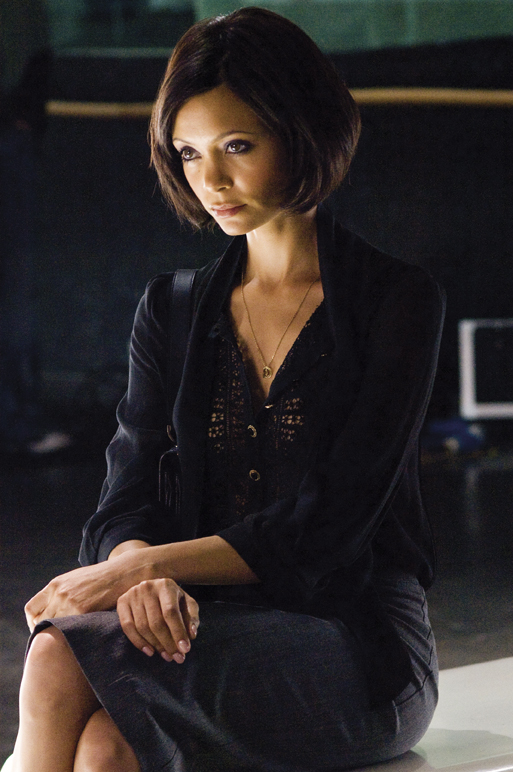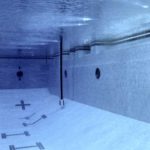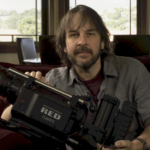
RocknRolla
Posted on Apr 23, 2010 by Alex Fice
Given a 31 day shooting schedule with a new camera and data workflow, DoP David Higgs shot log to give him some headroom in the grade and found a film discipline within a digital workflowIt’s another Guy Ritchie movie and it’s another ‘gangster fest’, no change there… Well not true because this time, with Rocknrolla, Ritchie has joined the ranks of high profile directors choosing digital cinematography and workflows to achieve their aim.
Part of that aim with this film was to stick to a 30 day shooting schedule with many different London locations, exterior and interior, day and night, mostly day. Maybe this condensed time frame was the reason he chose to shoot digitally as his next film is back to film with Sherlock Holmes, but maybe that’s a studio political decision.
Rocknrolla is definitely more of a non-political film in terms of studio involvement but ironically is still looking for confirmed distribution in the US where they see it as ‘too English’.
You could genuinely accuse the Rocknrolla crew as being too English as DoP for the movie was David Higgs who apart from a Bafta nominated short called The Stronger hadn’t used digital cinematography in anger before. “The Stronger had won at Raindance and personally I got a nomination for it. I shot that on a Arri D-20 which was the first time I had come across the camera, prior to that about a year ago I had done some testing for the BBC on the camera, that’s all.”
The instruction for Rocknrolla was digital from the outset so David looked at both the D-20 and the Genesis: “The fact that we were shooting HD was a given thing, Guy wanted to shoot HD and film wasn’t really in the running. I looked at the Genesis, but I knew that a lot of what I had to shoot was day interior/exterior and I thought that the D-20 worked in that kind of area quite well and I could take a few risks with it. Since I’d shot The Stronger with it I knew I was able to shoot log. I did a little test with Soho Images and the technical guy there, Laurent Treherne. We devised a LUT for the log but the simple thing was I just liked the way it looked. When I went to NAB I saw the CineTal monitor and saw that you could put a LUT on an image so you knew what you were aiming for, that was a big help for me. Ironically when I went to Arri I saw they had a CineTal in the engineering workshop, which they didn’t normally let out. Milan, Bill and Russell helped me out and enabled me to set that kind of system up with the CineTal.”

You can understand what a workable solution this was for David with the Director moving so fast and wanting a ‘look’ immediately on the monitor that the post house had already cleared, but how did the D-20 deliver it?
“The Genesis had a great look but had a slightly ‘Sony’ feel about it but because I wasn’t shooting many night interiors/exteriors I was more interested in how the highlights actually looked. The roll-off and the lustre that the D-20 gives really appealed to me, I really did like it.
“I thought I could take risks and let things burn out without them looking video and ugly and essentially looking filmic straight out of the can. Speed was also the key for us and having an optical viewfinder was very useful. The Genesis does strobe a bit when you pan.
“The thing with all these cameras is they change so much, the D-20 is now the D-21 and is not the camera you would use now. All of them seem to be constantly evolving which is the nature of digital capture. Obviously shooting log you are kind of fixed as far as your ASA is concerned in terms of what you’re looking at. You can generate LUTs which will emulate say 320 or 500 and you can do that on screen but I locked it to the one ASA and in my tests I knew that I had about a stop and half latitude above that if I wanted to lift the whole image to give me a 500 ASA look if you like. Beyond that I knew I would be stretching it. I would have loved to make some more LUTs as we were shooting but I just didn’t have time.
“The critical thing about this film rather than Guy’s others is that we had two weeks less time than any other film he had ever done. It was shot in 31 days, which is an incredibly tight schedule for what we had to do. That in turn impacted on what I was able to do. I had to do everything very quickly, we were shooting four pages a day! Also we had a lot of action to deal with and we didn’t have a second unit. Guy wanted to look at a monitor, know what he was getting and when he was happy then turnover.”
The brief from the director made David make some important production decisions about monitoring primarily and also the whole data route: “We didn’t have a traditional video assist just a CineTal monitor and a smaller monitor for the ‘B’ camera which I operated. We started off trying to record to the HDCAM SR portable decks but for the physicality of recording in London that really didn’t work and so we ending up switching to the Flash Mags on-board the camera and then downloading them on to the HDCAM SR decks later on the camera truck. That kind of made it workable, you just don’t want a load of BNCs running in and out of doors when you’re filming on location. The other problem with the HDCAM SR on-set is that the fans are too noisy.
“Shooting with the Flash Mags meant we were up and running much quicker. Time wise the mags gave us 10 and a half minutes in 4:4:4 which is about film length. You have to have a switched-on crew because there are chances of BNCs going down on one of the Flash Mags and then suddenly you are then recording 4:2:2 . The only way you know that’s happening is that your time goes up!
“The great advantage of working log was that we were able to lock to one core image and then go from there. I really didn’t have a lot of time to work lights on the floor so I used lights in a particular way that would give me and Guy a big look relatively quickly. When I met Guy the whole premise was really ‘I want to shoot quickly’. Ironically we didn’t particularly discuss a look for the film but things kind of fell into place really and we ended up with a look and a way of filming that worked with the film.
“Guy wanted a hot ‘summer-y’ look, he wanted it warm and that came out more when we graded it. When we shot it we had a softer more subtle look but when we graded it Guy wanted it more contrasty.”
 It illustrates how far shooting digitally has come over the last couple of years as there was a habit for DoPs to underexpose for the grade but now with new data shooting practices that isn’t necessary and in fact becomes a risk for producing more noise. “The great danger for anything digital is if it goes noisy – AKA grain for film – it never goes noisy in a nice way. The LUT we used gave me a rule book, a benchmark if you like. To be honest I was winging it quite a lot of the time, I had to look at the monitor and work out whether it was in the ball park or not. On the whole it worked out really, really well and what we got on the monitor on-set was the look that Guy liked. I’d rather use my eyes and my instinct than my meter but you have to be careful you don’t ‘light’ yourself up a blind alley. You can’t kid yourself it’ll be alright in the DI, you have to make sure it’s going to be OK in the DI.
It illustrates how far shooting digitally has come over the last couple of years as there was a habit for DoPs to underexpose for the grade but now with new data shooting practices that isn’t necessary and in fact becomes a risk for producing more noise. “The great danger for anything digital is if it goes noisy – AKA grain for film – it never goes noisy in a nice way. The LUT we used gave me a rule book, a benchmark if you like. To be honest I was winging it quite a lot of the time, I had to look at the monitor and work out whether it was in the ball park or not. On the whole it worked out really, really well and what we got on the monitor on-set was the look that Guy liked. I’d rather use my eyes and my instinct than my meter but you have to be careful you don’t ‘light’ yourself up a blind alley. You can’t kid yourself it’ll be alright in the DI, you have to make sure it’s going to be OK in the DI.
“Locking it to one LUT gave me some overhead, the danger with cameras like the RED and others is you can up the ASA rating but you‘re not changing your fundamentals, all you’re doing is changing the nature of the processing. On the D-20 I don’t think there is any analogue gain being supplied to the sensor to give any more information, I think the Silicon Imaging camera does but I don’t think any of the other sensor based cameras do. It’s all about the processing. So if you step away from the processing of the camera and say I’ll work with 200 ASA or whatever and then work the rest in the DI, then you’re on a little bit more of a sure footing than otherwise.”
Time restraints also stopped David revising anything with Soho Images as far as the LUT was concerned but he really didn’t need to anyway: “There’s no point really as I’ve seen it once already on the monitor on-set, but rather than DVDs I got MPEG rushes and was sitting down and looking at those occasionally but it was a busy old film.”
Lenses were Ultra Primes and Master Primes, David explains why: “Because the D-20 has a lustre and a softness to it automatically I didn’t want to go with Cookes and bring that slightly lower contrast look you get with Cookes. I think the D-20 gives a very filmic look and the media that automatically matches the D-20 is 35mm film. If you try to throw other HD cameras in, it really doesn’t work very well, it doesn’t match the D-20 as well as film. After we finished there were a couple of pick up shots in LA which were shot on a camera that made it really hard to then grade those images in to the rest of the film. When it came in to the DI it was a very video look and I really didn’t like it.”
Lighting for Rocknrolla was a normal film roll-out except there wasn’t time or opportunity for many big scaffold rigs except for one at Battersea Power station. “We were shooting 200 ASA so we’re not shooting that fast. I think the mistake people make (when shooting for HD) is you could say ‘we’ll shoot 1000 ASA so we’ll need less lights’. The point is that you still need points of light, unless you’re going for a particular monotone look you still need a number of lights to give you the point of lights to show a 3D environment on a 2D plane.
“The cost savings for shooting digital are more about the stock, I don’t think shooting digital opens a door to untold riches for production. You need the same level of crews as 35mm if not more. Our camera crew on Rocknrolla was eleven or twelve people. Digital was great with Guy as we could sit down and talk about where the light goes, for instance. ‘If you want her to turn her head that way I’ll have to light it so we can see her eyes’ ‘Alright I’ll indulge you’ he would say. It worked well as we very rarely did any playbacks apart from certain actions shots. He wasn’t one for many takes either, ‘One for fun then we’ll move one’.








